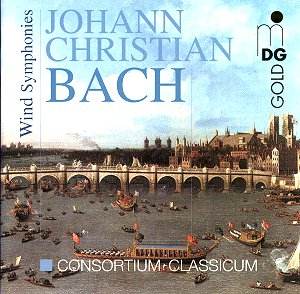Sheer delight in this
reissue of these 1991 recordings (originally
on MDG L3434). At the time they were
premiere recordings, as the booklet
notes attest. They have since appeared
at least once more, on Stradivarius.
All six are typically life-affirming
J. C. Bach. He was the so-called 'London
Bach', although the booklet notes claim
that he was also known as the 'Milan
Bach' at one point – a fact new to me
– due to his activities as Cathedral
organist to that city.
This is open-air music,
and affirms its origins with every note.
Of the slow movements, J. C. Bach forges
beautiful cantabiles (No. 1) and even
moves towards the interior emotions
(Nos. 2, 4). First movements buzz with
barely-contained energy, while finales
can be varied, from the hunting horns
of No. 1, the more laid-back No. 2 or
the cheeky and joyous (No. 3). Drama
and shadows do appear, but do not last
for long – Bach's love of life is too
great. If the ending of No. 4 doesn't
make you laugh or at the very least
smile, there is no hope ....
What is interesting
is that this composer can take a stock
text-book gesture such as the arpeggiation
that opens No. 3 and animate it with
an internal clean-cut and bracing vigour.
Further, he never outstays his welcome
– not a single movement is over five
minutes.
If there is a criticism,
both the Andante of No. 3 and the Andantino
of No. 5 sound on the slow side to me
(some excellent horn playing in No.
5, though). They still sound lovely,
though. The Collegiuum Classicum sounds
as if it lives and breathes this music.
Rhythms are marvellously taut throughout.
Mozart's debt to J.
C. in his own music for wind ensemble
becomes crystal clear on hearing these
works. But let us not forget these are
little gems in their own right. Reissuing
them has the effect of once more highlighting
these marvellous pieces in marvellous
performances.
Colin Clarke







